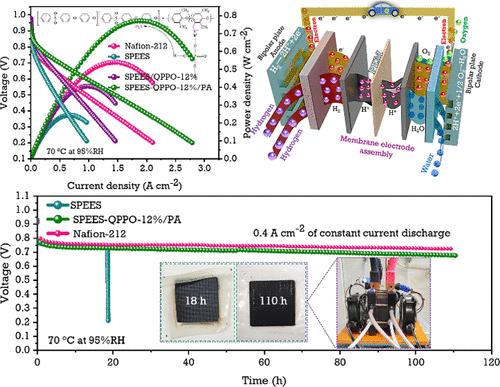高效H2/O2燃料电池中磷酸掺杂聚合物电解质的协同酸碱界面
IF 8.2
2区 材料科学
Q1 MATERIALS SCIENCE, MULTIDISCIPLINARY
引用次数: 0
摘要
开发高性能的高温质子交换膜(HT-PEMs)对于推进燃料电池技术的发展至关重要。本研究通过磺化聚(1,4苯基醚-醚砜)(SPEES)和季铵盐化聚(2,6-二甲基-1,4-苯基氧化物)(QPPO)掺杂磷酸(PA)的共混,展示了酸碱型PEMs的发展和优化。在PA掺杂的SPEES/QPPO聚合物网络中,磺酸(- SO3H)、季铵(- NR4+)和PA (- OH和- PO43 -)基团建立了酸碱相互作用。质子交换膜燃料电池(pemfc)的热机械稳定性、质子传导和耐久性的增强可归因于PA基团的功能贡献。实验结果表明,在90℃、95%相对湿度条件下,SPEES-QPPO/PA的质子电导率达到159.7 mS cm-1。在70°C、95%相对湿度下,该膜的最大功率和电流密度分别为0.770 W cm-2和1.835 a cm-2,在0.4 a cm-2恒定放电110小时内,具有优异的功率性能和最小的退化。根据研究结果,掺pa的混合膜的性能比原始SPEES高3.1倍,使其非常适合HT-PEMFC应用。本文章由计算机程序翻译,如有差异,请以英文原文为准。

Synergistic Acid–Base Interfaces in Phosphoric Acid-Doped Polymer Electrolytes for Efficient H2/O2 Fuel Cells
Developing high-temperature proton exchange membranes (HT-PEMs) with high performance is vital for advancing fuel cell technology. This research demonstrates the development and optimization of acid–base PEMs through the blending of a sulfonated poly(1,4 phenylene ether–ether sulfone) (SPEES) and a quaternized poly(2,6-dimethyl-1,4-phenylene oxide) (QPPO) doped with phosphoric acid (PA). In the PA-doped SPEES/QPPO polymer networks, the sulfonic acid (−SO3H), quaternary ammonium (−NR4+), and PA (−OH and −PO43–) groups established acid–base interactions. The enhancement of thermomechanical stability, proton conduction, and durability of PEM fuel cells (PEMFCs) can be ascribed to the functional contributions of PA groups. Experimental findings reveal that the proton conductivity of SPEES-QPPO/PA reached 159.7 mS cm–1 at 90 °C and 95% relative humidity (RH). The membrane exhibits a maximum power and current density of 0.770 W cm–2 and 1.835 A cm–2 at 70 °C in 95% RH, demonstrating excellent power performance and minimal degradation over 110 h of constant discharge at 0.4 A cm–2. According to the findings, the PA-doped blended membranes achieved a 3.1-fold higher performance than pristine SPEES, making them well-suited for HT-PEMFC applications.
求助全文
通过发布文献求助,成功后即可免费获取论文全文。
去求助
来源期刊

ACS Applied Materials & Interfaces
工程技术-材料科学:综合
CiteScore
16.00
自引率
6.30%
发文量
4978
审稿时长
1.8 months
期刊介绍:
ACS Applied Materials & Interfaces is a leading interdisciplinary journal that brings together chemists, engineers, physicists, and biologists to explore the development and utilization of newly-discovered materials and interfacial processes for specific applications. Our journal has experienced remarkable growth since its establishment in 2009, both in terms of the number of articles published and the impact of the research showcased. We are proud to foster a truly global community, with the majority of published articles originating from outside the United States, reflecting the rapid growth of applied research worldwide.
 求助内容:
求助内容: 应助结果提醒方式:
应助结果提醒方式:


